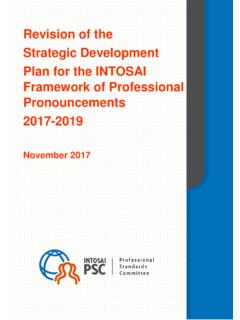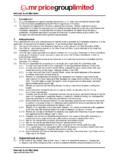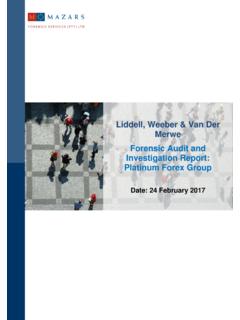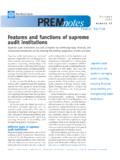Transcription of Appendix to ISSAI 3100
1 The International Standards of Supreme audit Institutions, ISSAI , are issued by the International Organization of Supreme audit Institutions, INTOSAI. For more information visit I N T O S A I Appendix to ISSAI 3100 2 Table of Contents: 3 nature and benefits of performance auditing 4 What is performance auditing? 4 External benefits 5 Internal benefits 5 3. The challenges of introducing performance auditing 6 Long term management commitment is needed 6 A proper mandate is vital 6 The importance of building relationships with stakeholders 6 Organizational issues need to be addressed 9 The key success factors 9 4. How to get started 11 Beginning small scale, with a pilot and focused themes 11 Determining the resources needed 11 Raising awareness within the SAI 13 Not setting up detailed systems and procedures at this early stage 13 5. Building the capacity for a sustainable performance auditing function 'maintaining the momentum' 14 Operational manager 14 Staff recruitment and training 14 Performance auditing framework 15 Communications strategy 18 the implementation of performance audit recommendations 18 3 Introduction Performance auditing greatly enriches public accountability and enables the SAI to make practical contributions to improving the efficiency and effectiveness of the public administration.
2 This guide aims to set out the benefits to an SAI from introducing performance auditing, together with some of the key issues to consider in introducing and maintaining performance auditing in an SAI. It is mainly aimed at the Head of the SAI and its senior management staff, to help them understand the requirements and challenges to be faced. The idea is to focus on the strategic needs and general implications of introducing a sustainable performance auditing function. SAIs operate under different mandates and models, and the size of SAIs and the administrative culture vary around the world. Therefore it is not possible to produce detailed guidelines applicable to all; so this document focuses on the strategic challenges concerned with the implementation process and the resources needed. It also highlights the key features of performance auditing and its importance to SAIs, public administrations and society as a whole. A significant number of SAIs have encountered difficulties in introducing a sustainable performance auditing function.
3 Besides political and administrative factors, the complexity and challenge of performance auditing itself should also be acknowledged. Experience has shown that it may take years to develop this form of audit work in a sustainable way. In addition, having a strong financial and compliance auditing function does not guarantee success in performance auditing, since performance auditing is a very different discipline. These guidelines consist of four main chapters: Chapter 2: presents the key performance auditing principles and describes internal and external benefits of this type of work; Chapter 3: points out the main challenges of introducing performance auditing; Chapter 4: highlights the key aspects to be considered when starting performance auditing; and Chapter 5: provides an outline of the principal issues for a sustainable performance auditing function. 4 2. The nature and benefits of performance auditing What is performance auditing? Performance auditing is an independent and objective examination of government undertakings, programs or organizations, relating to one or more of the three aspects of economy, efficiency and effectiveness, with the aim of leading to improvements.
4 The key principles guiding performance auditing may in short be described as follows: The principle of ECONOMY is keeping costs low. It requires that the resources used by the audited entity for its activities shall be made available in due time, in appropriate quantity and quality and at the best price. The principle of EFFICIENCY is getting the most from available resources. It is concerned with the best relationship between resources employed, conditions given and results achieved; in terms of quantity, quality and timing of outputs and/or achievements. The principle of EFFECTIVENESS is meeting the objectives set. It is concerned with attaining the specific aims or objectives set and/or achieving the intended results. Performance auditing is about analysing and assessing the performance of government programs or public services. It is an information-based activity that requires analytical and creative skill. In contrast to financial auditing, it focuses on the activity rather than the accounts.
5 And in contrast to compliance auditing, it relates mainly to the intentions behind government interventions and to the concepts of economy, efficiency and effectiveness. Basic questions in performance auditing are: Are the right things been done; If so, are things been done in the right way; and If not, what are the causes? The perspectives and the entities to be audited vary, individual departments as well as government programs and undertakings may be audited. Some of the main differences between performance and financial auditing are summarised below. ASPECTS Performance auditing Financial auditing Purpose Assess whether government interventions or measures have been conducted in accordance with the principles of economy, efficiency and effectiveness. Assess whether financial operations have been carried out in accordance with legislation and regulations and whether accounts and financial statements are true and fair, reliable. Focus Policy, programmes, organisation, activities and management systems.
6 Financial transactions, accounting, financial statements, and key control procedures. Academic basis and relevant experience Economics, political science, sociology etc. Experience of professional investigations or evaluations and familiarity with methods applied in social science as well as other relevant methods/skills. Accountancy and law. Professional audit skills. Methods Vary from audit to audit . Standardised format. audit criteria More open to the auditors' judgement. Unique criteria for the individual audit . Less open to the auditors' judgement. Standardised criteria set by legislation and regulation for all audits. 5 Reports Special report published on ad hoc basis. Varying structure and content, depending on objectives. Annual opinion and/or report. More or less standardised. External benefits Performance auditing has important functions to fulfil, both in relation to the general public, the legislature, the government and the entities that are audited.
7 The democratic principle is based on the public's right to hold governments accountable for their actions through general elections. In order for this principle to have significance, the public needs information on how public resources are spent and how public services perform. By providing objective and reliable information on these issues, performance auditing contributes to transparency and accountability. Performance auditing also plays an important role in keeping legislatures well informed about the government's actions, and the outcome of its own decisions. Legislature needs reliable and independent information on the results and effects of programs and decisions. Performance auditing represents a unique source of information, as it does not represent political activists or institutions. It may also be of value for Government to get an independent evaluation of the outcome of its decisions and the performance of public services. Performance auditing provides incentives for learning and change in the public sector, by providing new information and drawing attention to various challenges.
8 It also adresses problems that are beyond the audittee mandate by including the theme on the political agenda. It contributes to improvement and reform in public administration and government. In this way performance auditing adds value far beyond that of a control mechanism. Internal benefits Performance auditing enhances cultural diversity, creativity and learning in the SAI, leading the auditors to concentrate on relevant social, political and economic issues. It has the potential to make SAIs more visible in the media because performance auditing topics attract a wider audience. This can have a flow-on effect of increasing auditors motivation within the SAI due to the visibility of their work. Given that an objective of performance auditing is to identify potential improvements in the efficiency of public administration, (and therefore to help save government outlays) the credibility obtained from this type of auditing can provide greater incentives for governments/legislatures to allocate human and financial resources to the SAI.
9 6 3. The challenges of introducing performance auditing These are a number of issues that the head of an SAI needs to address when developing a sustainable capacity for performance auditing. Successful implementation of performance auditing requires political support, appropriate regulation, leadership and active management involvement. The head of the SAI needs to ensure sufficient funding and seek partners that may assist in capacity building and quality control. Long term management commitment is needed It is important that the head of the SAI takes into account that performance auditing is different, demanding and takes time to implement. The head of the SAI needs to communicate a clear vision of the purpose for performance auditing and the desired outcomes to be achieved. The introduction of performance auditing requires a personal commitment from the head of the SAI, and it is also important to get management actively involved and professionally trained.
10 Experience proves that introducing performance auditing will often require changes in attitudes, management style, organizational behavior, recruitment practices etc. It requires leadership to publish critical performance audit reports, especially in an environment less used to such criticism. It takes courage to reveal poor performance of government programs or services, even when backed up by reliable, objective and balanced evidence and arguments. Performance auditing requires skills which SAIs with limited or no experience in the field will have to acquire. A proper mandate is vital The head of the SAI should also seek to obtain a suitable legal mandate that comprises the following criteria: A mandate to carry out performance auditing on the economy, efficiency and effectiveness of government programs and entities; Freedom to select what to audit , when to audit and how to audit , conclude and report on findings; Freedom to place the audit results in the public domain; Access to all information needed to conduct the audit ; and Freedom to decide who to recruit.









